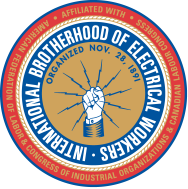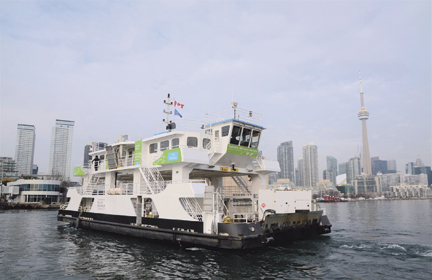The conversion of an airport ferry from biodiesel to electric power could help carry more marine-based work to the members of St. Catharines, Ontario, Local 303 and beyond.
“There’s a whole opportunity to electrify the marine industry and to be a leader in that, to be able to tie the IBEW to it,” said Mark Cherney, the local’s business manager.
In 2021, about a dozen of the local’s electricians working for Canal Marine & Industrial completed a five-week refit of the 30-metre MV Marilyn Bell I, a ferry that since 2010 has shipped passengers, vehicles and supplies to and from Toronto Island’s Billy Bishop Airport. The ferry went into full operation in 2022 as the first of its kind in North America.
Local 303 electricians replaced the ferry’s biodiesel generators and engines with an electric propulsion system plus a bank of lithium-ion batteries. The $3.8 million conversion cost was covered by proceeds from an airport improvement fee added to departing airline passengers’ ticket prices.
The now-electric Marilyn Bell I also has a first-of-its-kind automatic shore charging system, installed by Local 303 members at the foot of Toronto’s Bathurst Street.
The conversion of an airport ferry from biodiesel to electric power could help carry more marine-based work to the members of St. Catharines, Ontario, Local 303 and beyond.
“There’s a whole opportunity to electrify the marine industry and to be a leader in that, to be able to tie the IBEW to it,” said Mark Cherney, the local’s business manager.
In 2021, about a dozen of the local’s electricians working for Canal Marine & Industrial completed a five-week refit of the 30-metre MV Marilyn Bell I, a ferry that since 2010 has shipped passengers, vehicles and supplies to and from Toronto Island’s Billy Bishop Airport. The ferry went into full operation in 2022 as the first of its kind in North America.
Local 303 electricians replaced the ferry’s biodiesel generators and engines with an electric propulsion system plus a bank of lithium-ion batteries. The $3.8 million conversion cost was covered by proceeds from an airport improvement fee added to departing airline passengers’ ticket prices.
The now-electric Marilyn Bell I also has a first-of-its-kind automatic shore charging system, installed by Local 303 members at the foot of Toronto’s Bathurst Street.
According to PortsToronto, which operates the ferry, the electricity that powers the boat is derived entirely from wind and solar generation. The upgrade should eliminate about 530 tonnes of greenhouse gas emissions per year, equivalent to the annual exhaust output of more than 100 gasoline-powered cars.
The popular ferry’s 90-second, 122-metre route, which supplements a tunnel under the Western Channel, is one of the shortest in the world — a tiny fraction of the 51 kilometres covered in 1954 by the actual Marilyn Bell, the first recorded person to swim across Lake Ontario from the mouth of the Niagara River to Toronto.
Even so, the boat provides a crucial connection, carrying up to 200 passengers and 15 island-service vehicles on each trip. It makes four round-trips an hour, 19 hours a day and seven days a week, and its batteries get a quick, automatic top-off charge while the boat is docked.
Cherney said it helped that a new owner at Canal Marine and a subsequent reorganization a few years ago helped turn things around for the company. “It also changed the way we deal with the marine industry,” he said.
Canal designed, developed and maintains the Marilyn Bell I using workers from the local, Cherney said, with potential for more work in the marine space. “The opportunity to do that one opened up opportunities for more here in Ontario,” he said.
“The marine industry used to be a major part of this local’s work,” said Cherney, who recently was elected to a fourth term as business manager. But beginning in the late 1980s, that work almost completely dried up, he said.
Over its 113-year history, Local 303 has more than managed to roll with changing times and keep members working, adapting in recent years to take on more industrial and commercial work.
“We’ve had lots of history in a lot of different areas,” Cherney said. “Our apprentices get a lot of different perspectives of what’s out there.”
Local 303 also is getting ready for work on a hospital project and new apartments. Cherney said his members are seeing opportunities from the growing tourism industry and power generation projects.
“Our area here will change drastically” in the coming years, he said.
Even so, marine projects will always hold a special place for Local 303, Cherney said. There’s been talk about upgrading and manufacturing similar electric ferries for other clients, he added.
First District International Vice President Russ Shewchuk said projects like this help create opportunities for IBEW members that could only be dreamed about even 10 years ago.
“It’s a real chance for our hardworking men and women across Canada not only to capture the work but to demonstrate that the coming electrification of transportation and other industries to reduce our greenhouse gas emissions can provide an abundance of opportunities for the IBEW,” Shewchuk said.
According to PortsToronto, which operates the ferry, the electricity that powers the boat is derived entirely from wind and solar generation. The upgrade should eliminate about 530 tonnes of greenhouse gas emissions per year, equivalent to the annual exhaust output of more than 100 gasoline-powered cars.
The popular ferry’s 90-second, 122-metre route, which supplements a tunnel under the Western Channel, is one of the shortest in the world — a tiny fraction of the 51 kilometres covered in 1954 by the actual Marilyn Bell, the first recorded person to swim across Lake Ontario from the mouth of the Niagara River to Toronto.
Even so, the boat provides a crucial connection, carrying up to 200 passengers and 15 island-service vehicles on each trip. It makes four round-trips an hour, 19 hours a day and seven days a week, and its batteries get a quick, automatic top-off charge while the boat is docked.
Cherney said it helped that a new owner at Canal Marine and a subsequent reorganization a few years ago helped turn things around for the company. “It also changed the way we deal with the marine industry,” he said.
Canal designed, developed and maintains the Marilyn Bell I using workers from the local, Cherney said, with potential for more work in the marine space. “The opportunity to do that one opened up opportunities for more here in Ontario,” he said.
“The marine industry used to be a major part of this local’s work,” said Cherney, who recently was elected to a fourth term as business manager. But beginning in the late 1980s, that work almost completely dried up, he said.
Over its 113-year history, Local 303 has more than managed to roll with changing times and keep members working, adapting in recent years to take on more industrial and commercial work.
“We’ve had lots of history in a lot of different areas,” Cherney said. “Our apprentices get a lot of different perspectives of what’s out there.”
Local 303 also is getting ready for work on a hospital project and new apartments. Cherney said his members are seeing opportunities from the growing tourism industry and power generation projects.
“Our area here will change drastically” in the coming years, he said.
Even so, marine projects will always hold a special place for Local 303, Cherney said. There’s been talk about upgrading and manufacturing similar electric ferries for other clients, he added.
First District International Vice President Russ Shewchuk said projects like this help create opportunities for IBEW members that could only be dreamed about even 10 years ago.
“It’s a real chance for our hardworking men and women across Canada not only to capture the work but to demonstrate that the coming electrification of transportation and other industries to reduce our greenhouse gas emissions can provide an abundance of opportunities for the IBEW,” Shewchuk said.




